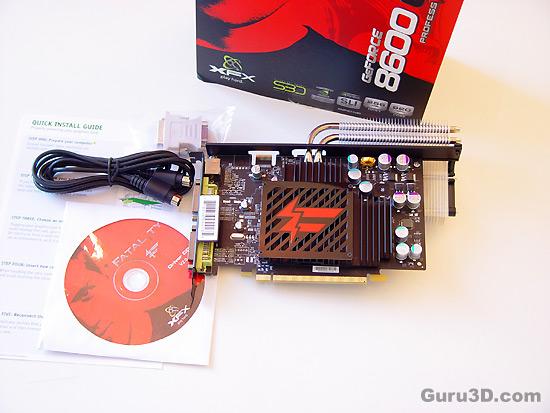Page 2 (In the box)
GeForce 8500 & 8600
To get you a better understanding of what product range we are dealing with let's have a look at some specs that I placed into a table.
| GeForce 8500 GT | GeForce 8600 GT | GeForce 8600 GTS | |
| Stream Processors | 16 | 32 | 32 |
| Core clock (MHz) | 450 | 540 | 675 |
| Shader clock (MHz) | 900 | 1180 | 1450 |
| Memory clock (MHz) x2 | 400 | 700 | 1000 |
| Memory | DDR2 | gDDR3 | gDDR3 |
| Memory bus | 128-bit | 128-bit | 128-bit |
| Memory bandwidth (GB/sec) | 12.8 | 22.4 | 32 |
| Transistor count | 210 | 289 | 289 |
| HDCP compatible | No | No | Yes |
Let's analyze a little. First off, the 8800 GTS and GTX are brilliantly performing cards. They have a lot power thanks to the sheer number of Stream processors (shader processors). The GTX has 128 units, the GTS cards have 96 shader units. If you do some generic math you'd know I expected the mid range products to have 48 shader units, but that's not the case. Merely 32 units are present in the 8600 series and actually a very shallow 16 on the 8500. Now since we are looking at a 8600 card today let's keep focus on that one.
The 32 shader units inside the GPU is not a lot, but for a mid-range product it could be enough if you give the product the proper what I call "framebuffer performance". The memory on your graphics card is very influential when you look at its bandwidth (the data speed which the GPU can work (read/write/copy) in. So I was surprised to see a 128-bit bus as in 2007 we should have really moved towards a 256-bit bus. 256-bit memory is dirt cheap so that's just not a logical step from my point of view. It's simple, the difference between memory for 128-bit versus 256-bit is half the bandwidth and has a very intense effect on the overall framerate of your games.
I would not be surprised to see 256-bit memory bus mid-range products later on in this year. Next: what's the physical difference between the 8600 GT and GTS you ask? Nothing, except the clocks and likely internal GPU voltage. So if you receive a GT that can overclock well, you could be able to bring it close to GTS speeds and save 50 bucks. Really it's the same GPU yet specified slower. Also good to know, every feature that is present on the 8800 series is also available on this chip architecture. Please read our reference GeForce 8800 GTX review for full documentation on these features.
So as you can understand the cards all will have full DX10 compatibility, which brings us to Microsoft Vista. I'll leave the driver discussion as it is right now but notice that only the 8600 GTS will have HDCP support straight out of the box.
So the tested 8600 GT today does not support HDCP content protection.
This brings us to XFX
The Fatality brand cards card are targeted at a very wide audience; today's tested card with a sales price of roughly 169 USD.
But what does that Fatality version entail ? Well, this is a pre-overclocked GeForce 8600 GT which offers higher than reference core and memory frequencies. NVIDIAs recommended clock speeds are 540 MHz GPU and 1.4 GHz memory (gDDR3 - 128-bit) for the GeForce 8600 GT series of cards. XFX has this card fully warranted for two years and pre-overclocked (default) at 620 MHz GPU and 1.7 GHz memory. Next we are looking at a nice dark design PCB and the thing that you'll love the most is it's passive cooling, which works really well as our tests will show. XFX promotes this under the marketing phrase Silent But Deadly (SBD).
The 8600 GT comes with two dual-link DVI connectors. Dual-link DVI allows extremely high resolution gaming up-to 2560x1600 (XHD as the industry would love to call that = Extreme High Definition) and all the sweetness in the form of HDR support and that final standard Shader Model 3.
Included in the box you'll find next to the XFX Fatality graphics card this lot:
- The graphics card
- DVI -> VGA dongle
- SVIDEO cable
- Quick install guide
- Driver CD, which includes NVIDIA® ForceWare unified graphics drivers, Full installation manual .pdf

The bundle is mediocre; no HD 3-way RCA bracket. Just the graphics card, SVideo cable, VGA dongle, drivers and manual. We can discuss all day about this, yet XFX clearly kept the bundle so skinny to keep the sales price down. So is that a bad thing ? I don't think so. The product as tested today costs roughly 170 EUR and can be found in the stores right now. Last thing you should know, your warranty is 2 years.
